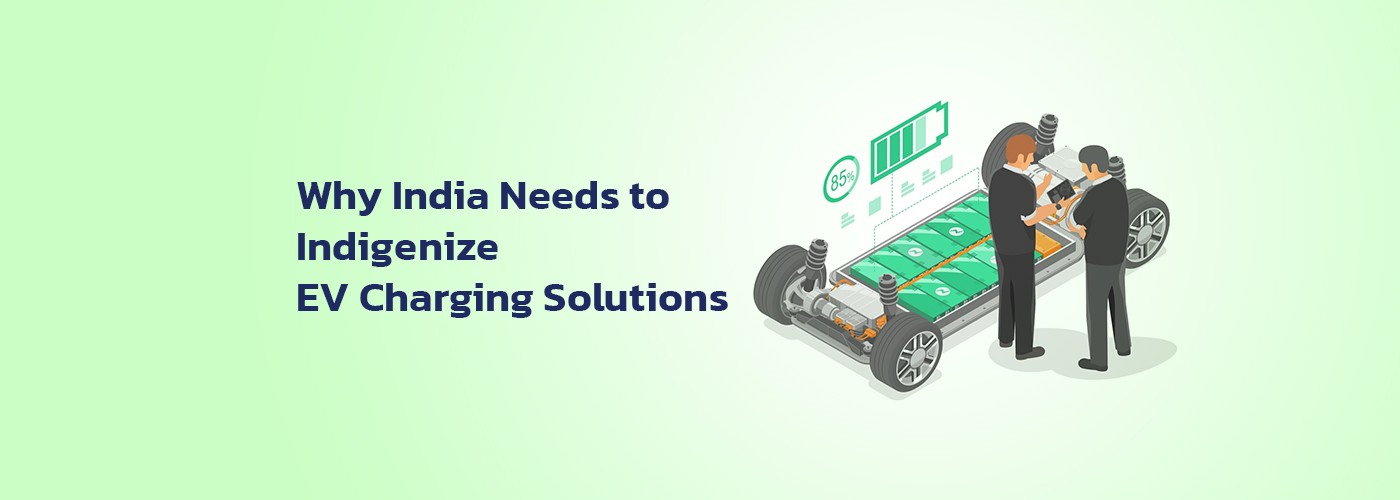Why India Needs to Indigenize EV Charging Solutions

The electric vehicle (EV) sector has been actively working to improve its adaptability and serviceability ever since it first entered the market, notably in India. But the scenario for charging and the price of the batteries have persisted throughout. Despite the rapid growth in EV sales, it is predicted that EV sales in India would soon plateau due to the requirement for affordable charging options. The necessity for designing and manufacturing EV chargers in India is still downplayed, despite the country’s need for indigenous EV charging solutions becoming increasingly louder.
Understanding the Need for Indian-Made EV Chargers
All stakeholders, including original equipment makers, suppliers, dealers, and utility players, need to pay attention as the number of EVs on Indian roads has also begun to rise. According to experts, the transition wouldn’t be complete without the application of cutting-edge technology that would result in revolutionary advances toward an all-electric future. If we talk about some of the biggest problems with the current EV batteries and other EV solutions throughout the world, safety comes out on top. The risk of lithium-ion batteries exploding increases in situations when EV batteries are exposed to hostile and severe environments for a protracted period of time. The fact that people in India could not use EVs to travel larger distances was another factor contributing to their bleak future.
According to data, an electric vehicle lithium-ion battery in India costs between 5 and 6 lakh. The Indian government is taking steps to establish charging hubs and stations around the nation, therefore the issue has been rectified and is currently being worked on. Nevertheless, China, one of the main producers of EV chargers, has excelled in this area for many years. However, the industrial industry in China has taken off since the COVID-19 epidemic arrived. This necessitates the adoption and introduction of indigenous EV charging technologies that can improve performance and battery life, such as Indian EV chargers.
Ways to Accelerate EV Charger Solutions in India
By 2030, it is predicted that there will be 5 crore EVs on Indian roads, based on the present development pattern. By that time, sales of EVs will be made up entirely of two-wheelers, with home and battery swap charging options, costs that are competitive with those of ICE vehicles, and a promising future for EVs in delivery services. However, a concurrent increase in the availability of charging infrastructure, on the order of 20.5 lakhs, would be necessary to sustain this enormous surge in EV use by 2030. With an average of 32 EVs per charging station in India, there are currently too few stations available.
To solve the go-no-go-issue issue the EV sector is now experiencing, significant measures must be done to establish charging stations throughout India.
- A certain percentage of EV-ready parking spaces should be required in all newly constructed residential and commercial parking lots.
- Even gas stations should be required to provide at least one charging station on-site.
- Policies should also take into account restricting the rental fees for public charging stations, improving access to land banks, lowering leasing costs, and developing a charging infrastructure investment facility partially backed by public funds.
- To reduce the initial CAPEX for starting the business and cover the related risks, a fund that is specifically curated for Charging Infrastructure must be created.
Establishing EV charging stations in India is currently quite expensive since one must pay for the license; however, if there is a specific standard for India, the cost will be much reduced. The BIS and DST have been tasked with creating the standards, and we anticipate seeing meaningful results from them soon. Till this point, there hasn’t been much progress made in terms of constructing charging stations under the FAME programs and by significant industry participants. The development of 5 lakh charging stations is already planned by a number of charge point operators, oil marketing corporations, as well as numerous center and state-led programs, thus the objective for 2030 appears to be attainable. A case in point is states like Andhra Pradesh and West Bengal have set goals for constructing a combined 1.00.000 charging stations by 2024 and 2026, respectively. Given that the numbers associated with EV adoption are still relatively low, battery assembly rather than cell manufacture is also required. When you talk about assembling in India, you may start with modules and move on to cells from there because everyone now imports cells. As a result, the battery management system and thermal management system still contribute a lot of value during assembly. Another option is the localization of the components. When it comes to automobile batteries, cell production comes last in the value chain.
Conclusion
In order to encourage the usage of hybrid and electric cars in India, the Central Government of India launched the FAME India Scheme in 2015. This program aims to minimize the amount of pollution produced by petrol and diesel-powered vehicles. In reality, the National Electric Mobility Mission Plan’s FAME plan (Faster Adoption and Manufacturing of Electric and Hybrid Vehicles in India) was introduced by the Ministry of Heavy Industries and Public Enterprises. Leveraging the uptake of hybrid and electric automobiles is a great approach.
This program encourages EV providers and manufacturers in India to market and produce more EVs and EV-related goods. The government of India wants to lessen vehicle pollution, therefore they created the FAME plan. FAME is pushing manufacturers to set up electric charging infrastructure with the goal of converting at least 30% of all transportation vehicles to EVs by 2030. Surprisingly, India has shown increased public confidence in adopting electric transportation with the growing number of charging stations installed. Additionally, the Department of Heavy Industries of the Union Government’s FAME initiative has led to the widespread installation of charging stations. Over time, this has also resulted in chargers being installed everywhere. Due to the significant growth in demand for EV chargers in India as a result of this, the Indian government is taking the required actions to foster innovation in the nation.




